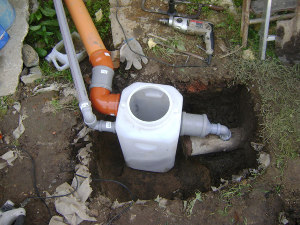From internal pipelines, drains are transported by external ...


You can’t save a lot on sewers. She knows how to pick up the last penny how. You can turn off, or almost turn off, heating, you can not heat the water, you can save by turning off the electricity ... But where to put the drains? They must leave the private house somewhere and be disposed of somehow. At least a cesspool must be present ...
It turns out that a cesspool can be the most expensive type of sewer for a home. And the cheapest, but effective removal of effluents can be done only by resorting to classical technologies ....
It turns out that its filtering ability, with modern washing-washing-shower (for the modern lifestyle of households) is insufficient. The pit quickly overflows with sewage, sediment, the water practically stops being filtered, due to the abundance of fats and the poor functioning of bacteria under the influence of detergents.
It is required to call an expensive sewage truck. But the dust does not have time to settle behind the leaving loaded car, as the pit demands its arrival again.
The result is the most expensive sewage system - the accumulation and subsequent removal of effluents in a car. A similar situation with a cesspool is not an isolated example.
With the increase in drains, with the advent of automatic dishwashers, washing machines, showers, or simply with an increase in the number of users, the old cesspools everywhere ceased to cope with their duties.
But technical mismatch is half the problem. There is still a question of legality - according to the standards, effluents discharged into the ground must be treated 95%.

To create a more effective filter for post-treatment with aerobic bacteria, in a pumped out and cleaned pit, you can simply put first a layer of sand 20 cm thick, and then crushed stone - 30 cm.
As a rule, for a small family, with a moderate amount of effluent, the filtration abilities of an ordinary cesspool, on the "average" soil, are technically sufficient for purified water from a septic tank.
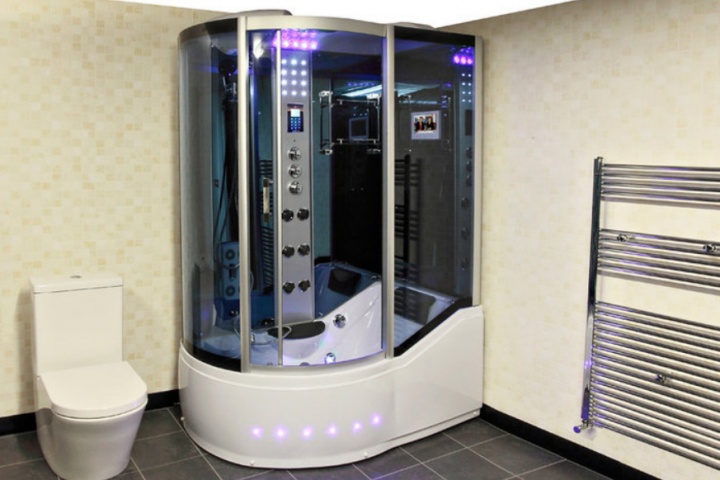
A family of 3 or 4 people, with reasonable water savings, produces a daily amount of effluent up to 300 liters. For each family member, 70 - 100 liters of effluents per day are received.
According to the standard, sewers must be created at the rate of 200 liters per day per person. But in fact, more modest technical capabilities are often required (up to 100 liters a day per person), so a filtering well in the form of an old cesspool can replace a modern filtration field.
Thus, one major sewer structure, a drainage well, is available on most farmsteads in a finished form. But it needs to be supplemented with a septic tank - an even more expensive structure in the classic version.
A solid precipitate precipitates in the septic tank, “difficult fats” are decomposed by anaerobic bacteria, the effluents are cleaned up to 60 - 70% and poured into a drainage well, where accelerated post-treatment of already aerobic bacteria takes place. As a rule, for a septic tank to perform its functions, it must be two-chamber, and of a significant volume.
Is it possible to somehow somehow reduce the cost of creating a sewage system, because often this is what is required in practice ....
The question is that the sewage system should not freeze, which means that the septic tank should be underground, and on top it should be covered with expensive insulation.
A foundation pit, reinforced concrete or brick construction of a septic tank, trenches - all this is very expensive.
The solution was found in the use of the so-called Eurocube, - containers made of polyethylene in 1 cubic meter. fenced metal grate mounted on a pallet (possibly made of metal). Its cost is much less than a septic tank made of plastic or reinforced concrete, and the purpose is the storage of technical fluids.

An example suggests that a working sewage system for a home can be created in just a few thousand rubles.
If we take the eurocube as a basis for creating a sewage system, then more often it is necessary to place it in a foundation pit with strong walls, anchor there with cables so that the container does not float, insulate from above. But, nevertheless, such a do-it-yourself septic tank is not expensive.
Two eurocubes with a bypass between each other form a two-chamber septic tank with a total useful volume of 1.8 cubic meters, which technically will ensure high-quality treatment of effluents of the "middle" house and will not allow siltation of the drainage well.
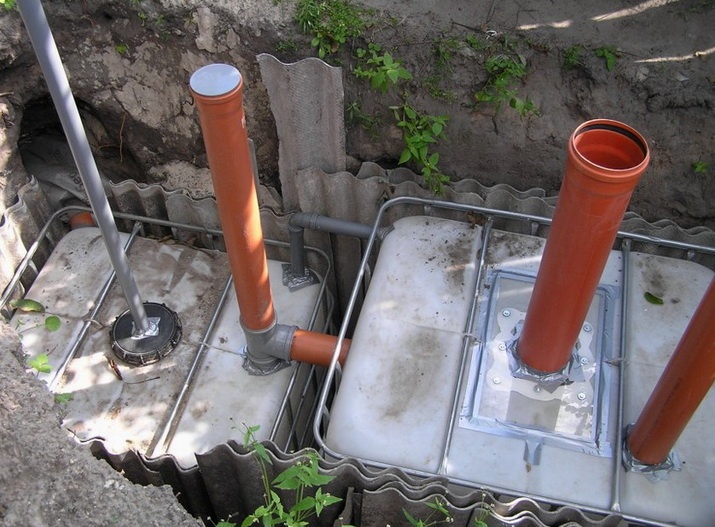
The difference in the level of the holes in each Eurocube is usually 15 cm. The second container is necessarily set lower by 20 -25 cm so that unused volume does not occur.


A reinforced concrete anchor is attached to the bottom of the pit, to which septic tanks are attached. Or for this purpose, reinforcement - locking anchors - is hammered into the walls at an angle.
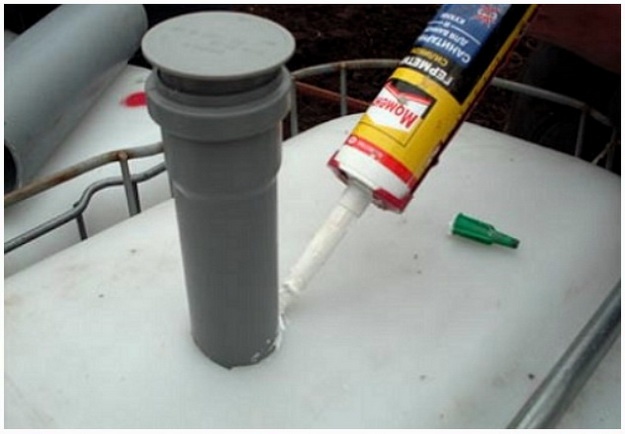
The pit is blocked by a reliable insulated floor. It is better to do it with the main of the corners, the rail. The use of extruded polystyrene foam with a thickness of at least 50 mm (better than 100 mm) is recommended.
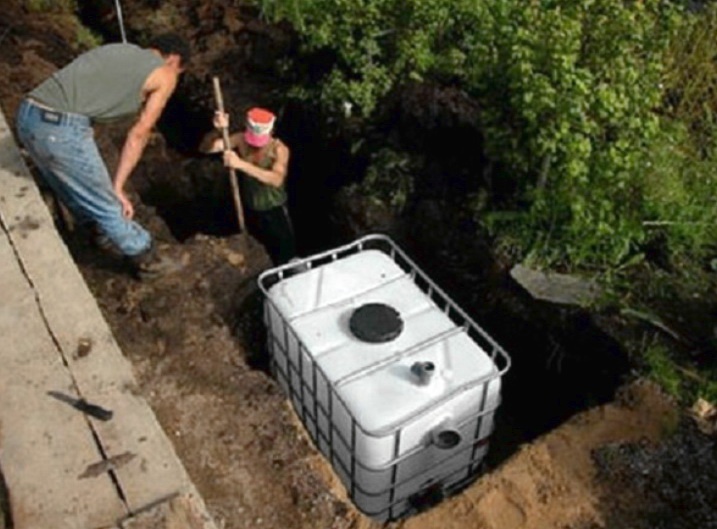
Sewerage in any private house is one of the most important elements that can provide a fairly comfortable life. If, until recently, our grandmothers and grandfathers who lived in villages and villages managed a regular cesspool, where all sewage merged, and which spread far from the most pleasant aroma throughout the district, now people are striving to establish a complete wastewater treatment system. Currently, many different systems are used, for wastewater treatment, from conventional storage tanks to complex biotechnological complexes for deep water treatment.
Wastewater treatment systems for a private house can be confidently divided into several main groups:
These are hermetic tanks that are installed below ground level and equipped with an accessible exit to the surface for pumping sewage accumulated in them. To equip such tanks, quite a few options are used, the simplest of which is ready-made containers made of metal tanks or plastic eurocubes in a protective metal mesh.
Installation of storage tank for sewage of a private house
In addition, the sewage collection tank can be made of concrete rings by installing them on a concrete pad and sealing all joints and technological holes, or pouring a concrete container directly in a dug pit. Despite the simplicity of design, such tanks are not quite popular due to the need for continuous pumping of wastewater with solid waste.
Only sewage machines with powerful pumps and tanks for pumped dirt can perform such work. Such a service in some regions is quite expensive, and given that you will have to access it regularly, the use of sewage system becomes overhead. Another significant drawback of sewage storage tanks is the risk of capacity destruction and sewage leakage into the soil, and then into groundwater, which can be used for water intake. This is especially true for metal containers, which, although treated with special protective compounds, inside and out, are nevertheless subject to corrosion due to the constant negative impact of the environment and chemical elements contained in detergents and falling into the tank along with wastewater. It is practically impossible to check the condition and integrity of a cistern or a metal tank buried underground, since it needs to be removed from the ground for this.
Such concrete structures, although more resistant to corrosion, are still destroyed by time.
Exceptions are plastic tanks, which are not afraid of corrosion. If, during installation, all protective measures were taken to protect the tank from external mechanical and physical influences, the storage tank made of plastic can last forever. The problem of plastic drives in limited sizes. Although modern technologies make it possible to melt sufficiently voluminous containers from plastic, their strength is practically not inferior to their iron counterparts.
This type of treatment plant is made of two types. The cheapest option is a drainage well without a bottom. To filter wastewater, sand and gravel mix are poured into the bottom of such a well. The volume of such a septic tank is limited by the volume of the tank, which is used as a drainage well. The most common way is to build a single-chamber septic tank of concrete rings that are mounted on top of each other in a specially dug pit. In order to prevent pollution from wastewater into the upper soil layers, where the root system of most plants is located, the joints between the rings are carefully sealed. This type of septic tank is recommended to be installed only in areas with the lowest possible groundwater horizon, otherwise, partially filtered wastewater and dirt can seep through a small thickness of the soil and contaminate groundwater sources. In addition to concrete rings for single-chamber septic tanks, metal tanks can be used, in the bottom of which sufficiently large holes are made to drain the drain.
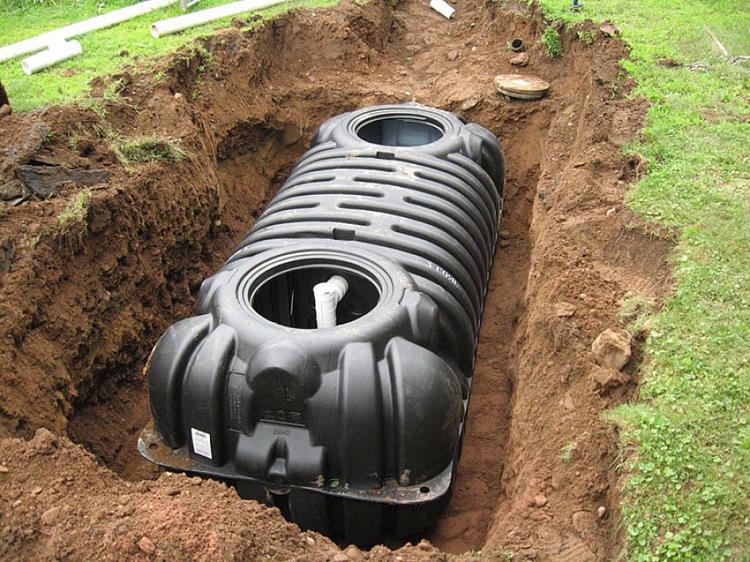 installation of a septic septic tank for a private house
installation of a septic septic tank for a private house A more acceptable option for a single-chamber septic tank, which is able not only to provide a sufficiently high-quality sewage system, but also not to pollute the environment, is a sealed tank with access to the filtration fields or infiltrator. Septic tanks of such a plan are sold in a finished factory version or are made independently. The design of treatment facilities with a single-chamber system is quite simple, which makes it possible to build it yourself. The sealed tank into which the sewage system from the house is connected can be made of any suitable material. Often these are the same concrete rings, only installed on a concrete pad to prevent sewage from entering the ground. This tank serves as a sump in which solid, insoluble dirt particles settle to the bottom, and lighter fatty and chemical particles, on the contrary, float to the surface.
Partially settled water from the middle layer through the overflow pipe is discharged to the filtration fields or infiltrator, which is finally cleaned and drained into the ground. The infiltrator, as well as the filtration field, is essentially the same mechanical natural filter from a sand-gravel mixture. To ensure better filtration, such a mixture is poured over a sufficiently large area, and wastewater is distributed along it evenly. Professional factory infiltrators can be equipped with a wastewater collection system to drain them not into the ground, but into the sewage system, if available nearby. The main disadvantage of such septic tanks is the need for periodic pumping of solid waste and activated sludge from the sump, as well as the replacement of sand and gravel as they become clogged and silted. Another drawback is the rather stringent conditions allowing the installation of sewers with a drain into the soil.
Devices with several connecting tanks are effective enough for wastewater treatment in a private house. To create septic tanks of this type, 2-3 sealed containers made of metal, plastic or concrete connected by overflow pipes are used. Often in these pipes additional mechanical filters and grease traps are installed to improve the cleaning process.
 installation of a multi-chamber septic tank with a fine cleaning system
installation of a multi-chamber septic tank with a fine cleaning system Basically, the first two chambers of septic tanks serve for water upholding, but unlike single-chamber septic tanks, sedimentation is of better quality. In one of the tanks, a so-called biological filter is equipped. For this, a colony of aerobic bacteria, which are actively involved in the decomposition of organic residues of human life, is planted in it. Unlike anaerobic bacteria used in cesspools and single chamber septic tanks, aerobic bacteria cannot develop without a constant flow of oxygen. For this reason, the arrangement is obligatory ventilation system. Depending on the size of the tank and, accordingly, on the volume of wastewater, ventilation can be produced with a natural influx or with a forced oxygen injection system. The advantage of forced ventilation in the constant flow of air for bacteria decomposing organic residues, but its energy dependence is its disadvantage. In the event of a power outage, the flow of oxygen stops, and bacteria can die.
After passing through several chambers of sedimentation and treatment using bacteria, wastewater is discharged into the infiltrator or aeration fields, which are also buried in the ground. When installing a system with aeration - filtration fields, it should be remembered that it is not recommended to plant fruiting plants above them and in a radius of several meters around. Otherwise, there is a risk that the plants will absorb dirt particles through the roots and pass them as harmful substances into the fruits that a person can eat. In an infiltrator with a plastic dome, this problem does not occur since the discharge of purified water occurs deep underground. The only limitation in this case is the planting of large trees with a developed root system, which can damage plastic.
Sewage bio-treatment stations in a private house allow you to get completely purified water, which can be reused for domestic needs, for example, for irrigation. These are complex devices resembling multi-chamber septic tanks in their design, but with a much more complex device that ensures their effectiveness and fully autonomous operating principle.
 biological treatment plant installation
biological treatment plant installation In addition to the sedimentation of water and the separation of fatty components that occurs in the first tank, the water discharged further and partially purified is saturated with a large amount of oxygen. This process is called fluid aeration. As a result, clarified water enters the chamber with active biological sludge, which is saturated with aerobic bacteria, actively involved in the decomposition of organics. The final step in cleaning is treating the water with chemicals that completely kill the bacteria.
Given that overflows, oxygen saturation and the forced ventilation system are controlled automatically, the treatment station needs a constant supply of electricity. In addition to this, stations of this type are one of the most expensive, albeit effective, methods of wastewater treatment. This leads to their small popularity among ordinary consumers. Often biological treatment plants are installed on several houses located nearby.
There are practically no restrictions for the installation of such structures, as deep cleaning and completely sealed reservoirs of the device exclude accidental pollution of the soil and groundwater.
The selection of treatment facilities depends on a number of specific factors that are individual in each individual case:
On average, one person per day accounts for from 150 to 200 liters of liquid discharged into the sewer. These figures are averaged and include not only direct drainage of water, but also the use of washing machines, dishwashers and other household appliances. The minimum volume of a septic tank must cover at least 3 daily volumes, that is, for one permanently resident person using sewage, a septic tank volume of 600 liters is required. For two people it will be 1200 liters for three - 1800 liters and so on.
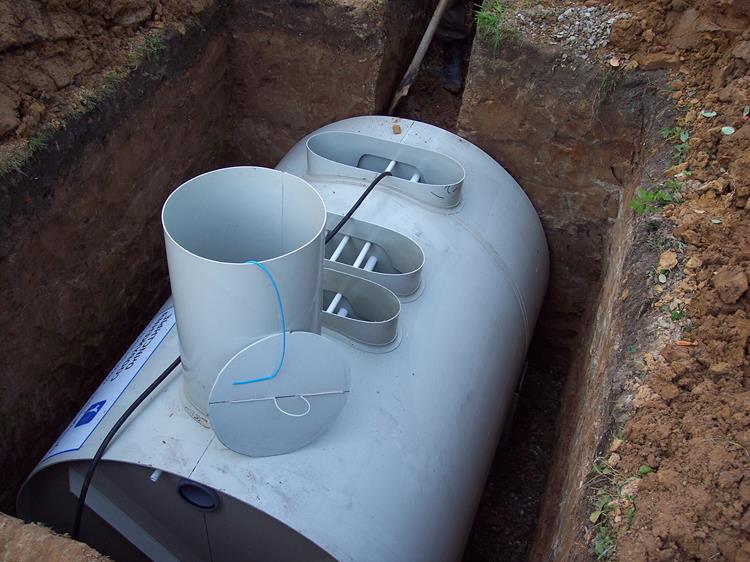 installation of a septic tank in the ground
installation of a septic tank in the ground In general, the rules for installing a septic tank or other type of treatment plant come from a number of individual characteristics, but there are general recommendations in this matter.
The foundation pit where the septic tank is installed must be insulated in order to exclude the risk of freezing of liquid in the tanks in the winter, when the temperature drops low enough. In some regions, it is also recommended to insulate sewer pipes discharging effluents from the house to treatment facilities. Given that sewage works on the basis of gravity, the installation of a septic tank must be carried out so that the sewer pipes are at an angle of at least 2-3 degrees with an inclination from the house to the septic tank.
During the installation of large enough treatment facilities, the foundation pit for them delves no closer than 3-5 meters from the capital buildings. Otherwise, there is a risk of subsidence of the foundation of the house. Also, sufficient removal will ensure that there is no smell in the living area, even if the septic tank fails and starts to smell unpleasant.
And of course, care should be taken to ensure that sewage from drainage wells or infiltrators does not pollute the environment. For this, it is not recommended to install treatment plants closer than 30-50 meters from wells for drinking water intake.
Have you just become the owner of a private house? So, probably you will face the issue of construction and arrangement of sewers. Without this, nothing, especially if you plan to stay in the house in the winter. Of course, the easiest way to entrust this matter to specialists. But frugal owners will prefer to make the sewers on their own, especially since this is affordable for everyone.
To begin with, we will determine the type of sewage system. The cesspool is taken as the basis of sewage, which can be:
Perhaps the easiest option for sewage. A huge pit is being dug up (with hands or equipment). The drain from the house is brought into this pit. Pipes are laid below the level of soil freezing. That's all - the sewage system is ready. This method is good in that it allows you to simply and quickly make a sewer without unnecessary costs. However, the bottomless cesspools have a lot of disadvantages:
Thus, increasingly, a cesspool becomes only the basis of future sewage, and its main part is tanks or septic tanks.
A cesspool is dug into which a deep sealed container is placed. The end of the sewer pipe from the house should fit snugly into the hole in the tank. Water accumulates in the tank, so it will have to be cleaned periodically.
Advantages of tanks:
However, the tanks have a significant drawback: quite often you have to clean it from sewage water using a special machine.
The most modern solution for arranging a sewer pit is. Septic tank is a kind of filter that purifies sewage water and makes it safe for nature. That is, water from the sewage system will not be so dangerous if it gets into groundwater or natural bodies of water. Septic tanks are different. Let's look at the main types of septic tanks.
Single chamber septic tanks represent a container for the reception and sedimentation of wastewater. Additionally, you will have to equip a well that will filter drains. Filtered water will enter the soil without causing any harm.
Advantages of the system:
Disadvantages:
Two chamber septic tanks combine two containers: for sludge sedimentation and filtration with subsequent discharge into the ground.
Benefits:
Disadvantages:
Septic tanks with a filtration field They are a two-chamber septic tank with a mechanical wastewater treatment system through a special drainage system.
Benefits:
Disadvantages:
 Septic tanks with biological treatment The most advanced sewage solution. Water treatment is carried out using, which guarantees almost complete wastewater treatment.
Septic tanks with biological treatment The most advanced sewage solution. Water treatment is carried out using, which guarantees almost complete wastewater treatment.
Commonly used biofilters for deep cleaning. Such septic tanks have a high quality of treatment and discharge of treated water.
First you need to choose the best place for the cesspool. Whatever method of arranging the sewage system you choose, the pit should correspond to some parameters:
We draw the scheme according to which we will work. On the diagram, place all the objects of the future sewage system. Work is best done in dry weather, preferably in summer.
We buy all the necessary materials. To install the sewer we need:
